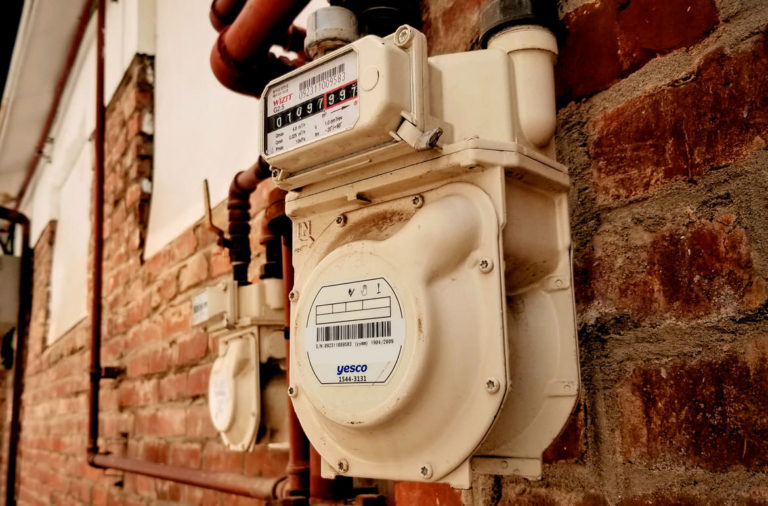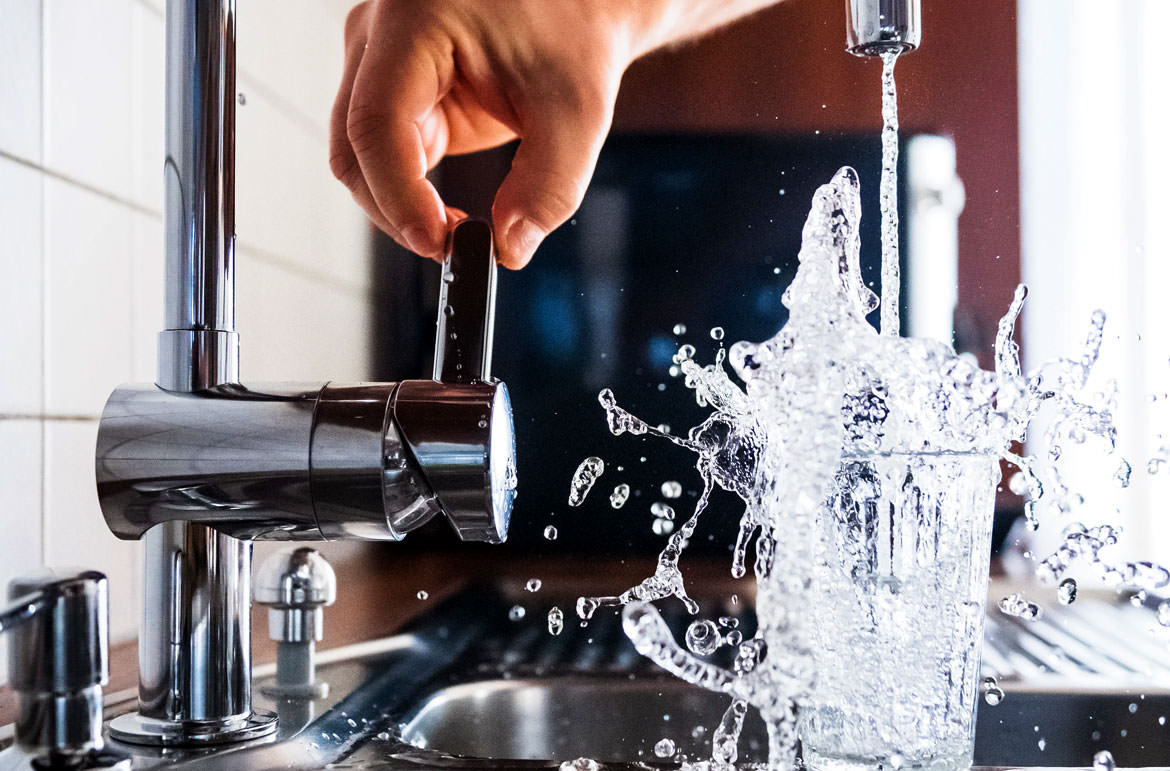
When building your granny flat, plumbing is a major concern. So how do you plan for your granny flat plumbing and sewerage?
It is important to first understand where your main water will be coming from, where the council mains are and how you will direct waste water from your granny flat. From here you can map everything out.
In this post I will cover how to plan for your granny flat plumbing and sewerage in detail.
DON'T PAY A FORTUNE FOR YOUR GRANNY FLAT. Find out how to deal with council and build a granny flat for the lowest cost possible. Learn More.
How to save on costs, what you may be able to do yourself and how to make the whole process as easy as possible.
I do this with the help of David Mikkelsen. The owner of Fluid Plumbing, the Central Coast’s (NSW) largest plumbing company with over 20 years of experience.
So, let’s get right into it.
What should you consider when planning a granny flat sewerage system?
David mention’s location is a biggest thing to consider.
“You want your granny flat, or the drainage at least to be lower than your existing mains which feed water into the dwelling.”
Basically, if your granny flat waste drainage is higher than the source of mains water it will have to go into an underground pit and a pump will be needed among other issues (which I cover below).
The secondary problem is, council won’t approve such a system without extra certification.
Extra approval will be needed for this system as it won’t come under your regular compliance for a granny flat.
Even if you are planning to build though a Complying Development Certificate (CDC) and not through a Development application (DA) you will require extra approval.
The Ideal Scenario:

The ideal scenario, where physics works on your side and water is “gravity fed” to your granny flat
And the Scenario which includes further complications and an extra pump:
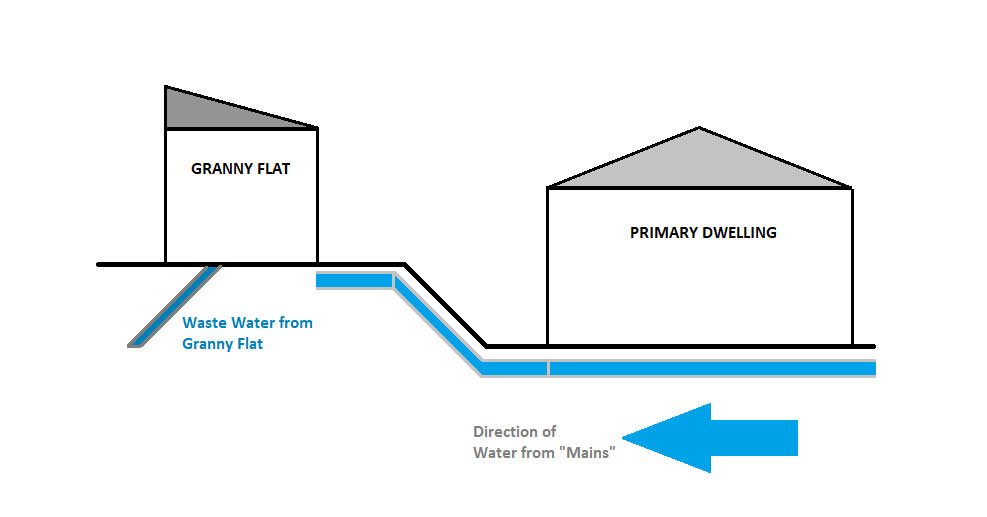
The “non-ideal” scenario where you are working against gravity
The greatest complication is really to do with gravity and the laws of physics.
NOTE: Do what you can in the planning phase to work with your land, ensuring fluid can enter the granny flat from a higher level and leave at a lower point.
What to do if drainage can’t work with gravity?
Firstly, David covers some basics for us:
“Every property is only allowed one junction from the council sewer main into that property. And if you’re planning on building the granny flat lower than what that existing junction is, obviously the sewer is not going to flow into it.”
So, then you’re going to have to dig an underground pit somewhere. The waste fluid will be fed into this pit. You will then need power to the pit to run a macerating pump.
The pump will force the waste against gravity and out of the granny flat.
Once approval has been given by council for such a set-up it will be logged in their records. This log will ensure that your local council knows there is a macerating pit with a pump that requires yearly maintenance. The cost to dig the pit, install the pump with on-going maintenance makes this by the far the most expensive option. However, it may be your only one.
David mentions that the setup cost for uphill plumbing could be double the cost, depending on your specific circumstance of course.
Connecting Water and Waste to Your Granny Flat
You’re only allowed to have one connection from the council sewer main into your block of land.
This means the granny flat’s waste water will have to tap into the line from your main property (the primary dwelling).
And David knows there are complications with this, especially if you are fighting gravity.
David recalls that his team has seen occasions where it’s been cheaper to dig up the council main for sewerage, (if the council mine is lower) and there’s the potential to put another junction somewhere else for the entire property.
The issue is you would have to re-divert all of the original house sewer to that new junction as well.
Plus council will charge you a fee to cut open their main, which won’t be cheap. You will have to find out what your local council will charge for this.
You would also have to cap off the old junction – as mentioned; you’re only allowed one junction per property.
Building over a Council Main. Can it be Done?
Yes, however again this comes with a few demands by council.
Here on the Central Coast in NSW, council may allow this to occur with some rules.
The main rule being:
- Concrete casing of the main line.
To ensure that the line is completely safe from fractures and cracks. Once you build over a mains line there is no way of accessing it, so it needs to be “set in stone” so to speak.
Again, this is a pricey exercise.
After set up costs of such a job, you can bank on roughly $1000 per metre for the necessary concrete casing work.
Doing the math; if you are building 10m of pipe, this will be about $10,000.
It is best to speak with council to get your Sewerage Connection Plan. Such as the one below:
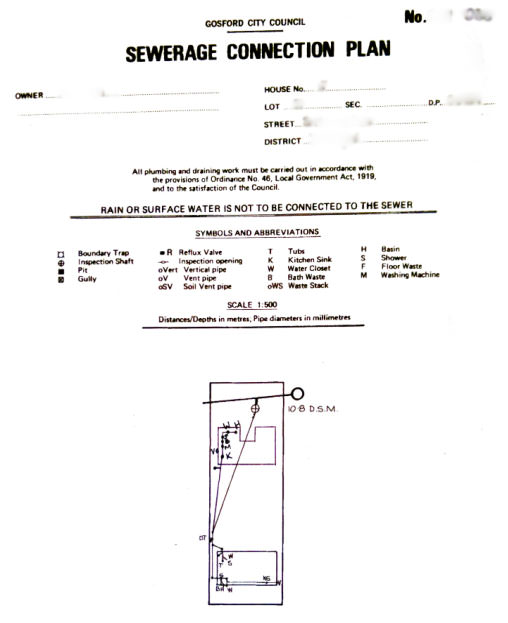
A plumbing plan can be obtained from council, so you can see where the mains line and connections already are on your land.
This will indicate where the fluid passes across your land and will indicate where council has placed their mains and sewerage lines.
You can get this diagram from your local council.
It is also worth noting that it’s best to confirm where any underground cables are on your land, using Dial Before You Dig as well. Not only is this a requirement for your own safety, it will help you plan when it comes to excavating anything on your land.
Plan Outside the Zone of Influence
When it comes to Council’s mains, it is important to note that to save a lot of headache you want to avoid building over their drainage (as mentioned above). However, you also want to avoid building near their mains as well.
This is called the “Zone of Influence” From my local council they explain it this way:
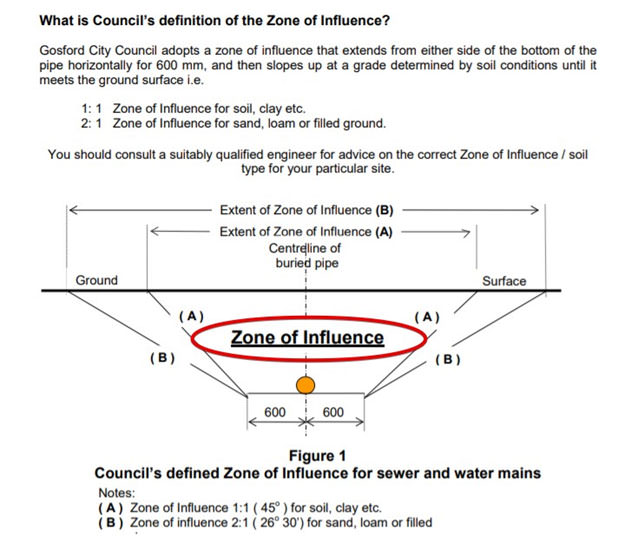
Source: Central Coast Council
The diagram above shows that if you are building next to a sewer or water mains and it is 1m deep you will have to locate where it is and build 1m away from it.
A real world example is shown below:
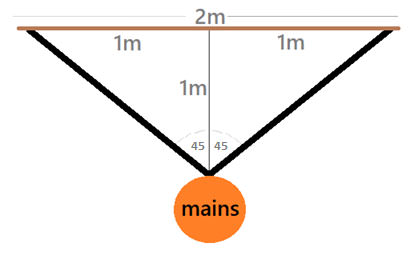
A cross section for how to see the “Zone of Influence”
If you are building on sand, loam or back-filled ground, this “zone of influence” will need to be even bigger.
Can you do your own granny flat plumbing and sewerage?
No. A licensed plumber needs to do it. In Australia; unless you yourself are a licensed plumber you are not allowed to do your own plumbing or drainage.
Technically, you may be able to find a plumber and do some of the work yourself. However, the plumber would have to sign off on the work you did.
Understand however; it will be difficult to find a plumber who will put their license number against work they did not complete themselves.
Illegal Plumbing work – What Can Happen?
If plumbing work is done illegally, the registered (licensed) plumber assigned to your granny flat work could lose their license.
For example, if you installed your drainage wrong and the council main surcharged, (it flooded back into your house). The plumber who listed their license number against the work will be responsible.
The necessary council inspections are designed to prevent this from happening.
Such as:
- Ensuring the surcharge gully has been installed at the right height, and depending on the heights of the sewer, check if there’s a reflux valve that’s put in there.
When it comes to government enforcement’s for example; for the hot water heater, if the plumber hasn’t put in a tempering valve and somebody gets burnt, the plumber could lose their license, or even worse. Including possible jail time.
The fines are very serious as getting things wrong could mean potential loss-of-life.
How to get a Warranty on Plumbing work
You might be asking; Do plumbers provide a warranty on their work?
David mentions that it is up to the individual business and they should provide a warranty for their work, just like fluid plumbing does.
This is not instated by any government mandate. Therefore, it is up to you to discuss what warranty your plumber will provide you.
How to Pick the Best Plumber in Your Area?
There are a few basics you need to confirm with a plumber:
- Check they are fully licensed
- Check they have insurance to carry out the work
- Check they have reviews online
- Check they have been established in your area for years.
The reason for the last point, is you don’t want a plumber that doesn’t have a reputation to uphold.
If they decide to change their phone number or leave town, you are not going to be left holding the mess.
Another suggestion, is to ask the plumber for referrals directly. You can call people whom he helped with their granny flat and see what their opinion is of the plumber.
Most importantly; you can see how everything is holding up, weeks or months down the track.
When you Need Your Plumber On-Site
Unlike an electrician installing wiring for your granny flat, you will need a plumber on site for council inspections.
There are generally 3 inspections:
- When pipes are laid in the ground, once trenches are dug (connected to council mains)
- Once the rough-in is completed, pipes fitted internally (before walls plastered)
- Final inspection to ensure everything is completed correctly
When planning a council representative to be there for the inspection, you will need to coordinate your plumber for these meetings as well.
If a plumber has a lot of work on, and is on the other side of town, this will be challenging for you to co-ordinate.
As an owner-builder it is important for you to manage this correctly.
How to Save Money on Plumbing and Sewerage Work
There is a lot of ground work for when your granny flat plumbing and sewerage comes together.
One of the main tasks is digging the ditches for the plumbing to pull mains water to the secondary dwelling and to have room for waste to drain out of the granny flat.
You may be able to arrange this work with your plumber and save a lot of man hours.
In general; you need at least:
- 300mm of ground cover over pipes
- If under concrete it can be 100mm
There may be a “zones of influence” you need to consider and a few key elements like such as this. However, if working together with your plumber they might allow you to do this.
NOTE: If there is 300mm of ground cover required, you will need to dig to 500mm, for ground cover (blue metal for drainage plus the pipe thickness to be accounted for).
David gave a great tip at this point in our conversation:
“It can sometimes create more work and more expense, if the floor of your trench is not smooth, the plumber is going to have to put more blue metal in to level out the bottom of the trench, and that can be expensive. You don’t want to dig it too deep in spots, or have the trench wavy at the bottom, it needs to be smooth.”
You don’t want a plumber to arrive for a day’s work and say “Thanks, but you haven’t really helped me.”
Plumbing for a Granny Flat on a Concrete Slab or Piers?
Straight away, David mentions by-in-large it is easier for a plumber when a granny flat is built on piers.
“If it’s up on piers, you could have the roof on, floor down, obviously no lining inside, just your external cladding. Then a plumber could come in, do all of his penetrations through the floor and run all of the aerial drainage in one visit.”
Same with doing the rough in, that could all be done in one visit. And then the connection to the main could be done separate as well. Simply wait until the house has then been sheeted and tiled (walls), and then it would just be fit-off (Finalising everything).
Essentially; three visits in most cases.
With a concrete slab there would be an extra visit.
Because a plumber will have to do the drainage, then the slab will have to be poured, then the plumber will have to come back once the frame’s been put up to do the rough in.
Whereas, if the granny flat is on piers and you can get underneath the building. No need to wait for a concrete slab to dry either.
The main reason building on piers is easier for a plumber is the margin of error available. There’s always a margin of error with aerial drainage, when it’s a slab you’re relying on somebody else’s set out of that slab. And this is where mistakes can be made.
If somebody is setting out the slab and saying, this is the outside wall of that slab, this is the internal walls of the building, sometimes there can be errors made.
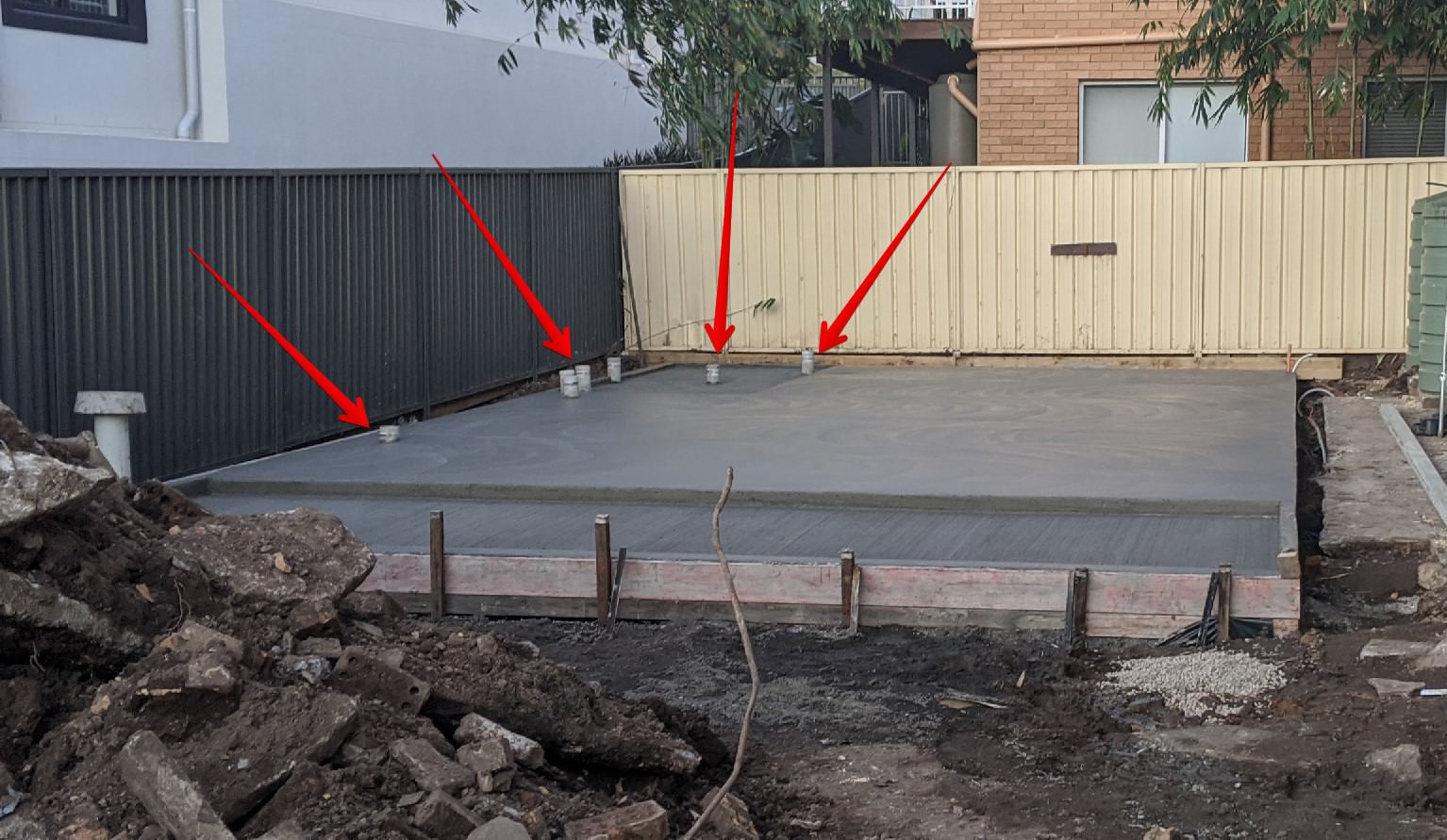
A granny flat being built in my area on a concrete slab. You can see how the pre-planning of your drainage needs to be perfect.
Because then you’re turning up the points for all of your drainage, and if they’re out by even 50mm for a toilet it can be really costly in a slab because then you’re jack hammering it up to fix the mistake made.
If it’s an owner-builder then it can mean arguments about, well, who set out that line? Is that the correct mark?
Whereas if it’s on piers and the frame’s up, the walls already built, there can be no communication issues about where that wall is.
Other Common Pitfalls for your Granny Flat
The Surcharge Gully, which directs sewerage one way in the event of a flood is vitally important.
Every granny flat has to have a surcharge gully and there’s rules about the height of its location.
It has to be at least 75mm below the internal floor height of the building, but 50mm above the external height. And that can be difficult with landscaping around the outside of the granny flat.
David mentions this is something to be aware of:
“So I’ve seen that happen where people haven’t allowed for that, and now there’s concrete outside at the same level as an internal floor height, and plumbers can’t get the required gully height. The council will make you rip up the concrete and do it correctly”.
Ensure that your licensed plumber doesn’t cut corners based on the AS3500 – The Australian Plumbing code, which stipulates rules such as the surcharge gully height.
Installing The Water Tank for your Granny Flat
You must install a water tank as per BASIX requirements for granny flats.
This will be filled with the rain run-off from your granny flats roof and is a necessity to save on water.
This water will generally be used for the toilet, outside tap and washing machine.
However, you will need a pump to draw water from this outside tank to these parts of the flat.
- The cheapest pump is just a pump directly from your tank straight to whatever it’s feeding.
Be aware that there is a major issue with this basic type of pump and that is:
What happens when the tank runs dry?
- You could manually top up that rainwater tank
- And there’s also automatic top-ups to your rainwater tank
You can go with the cheapest pump, it’s only going to be a couple of hundred bucks. But if you don’t have any rain for a while, your tank’s going to run dry. There are systems to make the tank always top-up. If it gets down to 20% then it will top up with mains water, for instance.
David mentions:
“Probably the most fail-safe method, that’s going to have the least problems, is an automatic top-up on your rainwater tank”
Overflow of your Rainwater Tank
As part of my CDC requirements for the granny flat I also needed to have a pit for the overflow of the rain water tank.
If you imagine that after heavy rain the tank will naturally overflow. This overflow needs to be directed to an underground pit so the water can naturally disperse.
This needs to be placed at a point lower than the tank. There are also restrictions to how close it can be dug to the granny flat and to your land boundaries.
How Should You Cost the Plumbing Work for your Granny Flat?
David mentions:
“I would ask for a quote for the whole job, but you will want to know all of the specifications on what you’re putting in the granny flat. If you say:
I want to quote on all this plumbing and sewerage, but I don’t know what toilet I want, and I don’t know what vanity I want, and I don’t know what type of kitchen I want, and I don’t know what size rain water tank I want, and I don’t know what hot water heater I want. It’s very hard for a plumber to give you an exact price.
But if you can give the plumber a list of, what you will source and the exact specifications of these items you can get a fixed quote for the work.”
David summarised our chat about quotes by mentioning that it is not advisable to buy a toilet from one of those cheap online sites for example.
Some of these sites will be very vague about the exact specifications of the toilet for instance.
If a toilet is off by 50mm, from the plans a lot more work needs to be done. Especially if you are building on a concrete slab!
This is very common for plumbers to work towards an exact specification and it throws a huge spanner in the works when the products to be installed are different to where the pipes where placed during their first visit.
Conclusion
Plumbing is a vital part of your granny flat build. It cannot be done by you or outsourced to a ‘handyman’ as such. It needs to be carried out by a licensed plumber who will fill in a “Notice of Work” which will need to be submitted to council.
Regular council inspections will be carried out.
This is due to the strict rules enforced by council about where water flows to the granny flat and where the waste water flows from the dwelling.
Due to BASIX requirements and to ensure your secondary dwelling is as energy efficient as possible, a rain water tank will need to be installed. The size of which will be dictated by your BASIX report that needs to be purchased.
There are strict regulations about how the rain water tank is installed and how the overflow of this tank will be dealt with as well.
I’d like to thank David Mikkelsen for his knowledge, experience and time to prepare this post. And I hope this post has shed light on what is required for your granny flat plumbing and sewerage.
If you would like to learn more about building your own granny flat click here.



